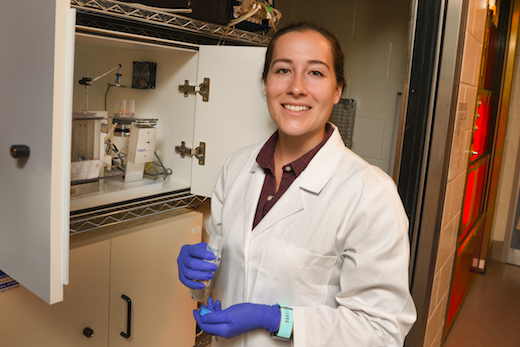Stephanie Foster sees herself one day specializing in addiction psychiatry. When she started her MD/PhD studies at Emory, she sought out neuroscientist David Weinshenker to discuss research projects. She is now examining potential treatments for opiate addiction based on galanin, a neuropeptide found in the brain.
Weinshenker and his colleagues had already been studying galanin in relation to stimulants such as cocaine. Preliminary studies in animals indicate that activating galanin signals might reduce the rewarding effects of opiates, withdrawal symptoms, and relapse-like behavior.
“This was a whole new direction that looked promising,” Foster says. “But first, we have to work out the brain circuitry.”
Foster comes from a Native American background, and has a long-range plan to work in the Indian Health Service. The death rate of Native Americans from opiate overdoses is the highest of any American population group, according to the Centers for Disease Control and Prevention. She would like to establish a research lab in a region of the country where she could continue her addiction research and also work closely with Native communities.
Last year, Foster applied for and received an individual grant from the National Institute on Drug Abuse to support her work. Emory currently leads U.S. universities in the number of graduate students holding their own active grants from the National Institutes of Health. This reflects a multi-year effort to build instruction in critical parts of scientific life: planning and communicating about one’s work.
With opiate addiction, convincing others that the topic is worthwhile is not so difficult. Foster notes that few treatments are available for the early stages of opiate addiction. Long-lasting opiate substitutes/replacements such as methadone and buprenorphine are used once dependence has set in, and another medication, lofexidine, was recently approved for acute withdrawal symptoms.
“There isn’t really anything for people before they reach that stage,” Foster says. “Our idea is to look for an intervention that could be given earlier.”
Foster’s research will test whether galanin signals can reduce opiate use in animals, and to determine which brain regions are important for galanin’s effects. First isolated in the 1980s, galanin is not as well-known as other neuropeptides such as oxytocin, involved in forming social bonds, or hypocretin/orexin, absent in the most distinctive form of narcolepsy. Some experimental drugs can activate galanin signals (one is called “galnon”) but none are available off the shelf.
Foster and Weinshenker suspect that a key site in the brain for galanin’s action, in relation to opiate use, is the locus coeruleus or LC. A region of the brainstem, the LC has connections all over the brain, and is thought to be involved in arousal and attention, stress responses, learning and memory, and the sleep-wake cycle.

